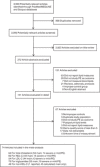Maternal hyperlipidemia and the risk of preeclampsia: a meta-analysis
- PMID: 24989239
- PMCID: PMC4565654
- DOI: 10.1093/aje/kwu145
Maternal hyperlipidemia and the risk of preeclampsia: a meta-analysis
Abstract
Published reports examining lipid levels during pregnancy and preeclampsia have been inconsistent. The objective of this meta-analysis was to test the association between preeclampsia and maternal total cholesterol, high-density lipoprotein cholesterol (HDL-C), low-density lipoprotein cholesterol (LDL-C), non-HDL-C, and triglyceride levels measured during pregnancy. We conducted a systematic search for studies published between the index date until July 2013 reporting maternal lipid levels in women with preeclampsia and normotensive pregnant women. Seventy-four studies met all eligibility criteria and were included in the meta-analysis. Weighted mean differences in lipid levels were calculated using a random-effects model. Statistical heterogeneity was investigated using the I(2) statistic. Meta-regression was used to identify sources of heterogeneity. Preeclampsia was associated with elevated total cholesterol, non-HDL-C, and triglyceride levels, regardless of gestational age at the time of blood sampling, and with lower levels of HDL-C in the third trimester. A marginal association was found with LDL-C levels. Statistical heterogeneity was detected in all analyses. Meta-regression analyses suggested that differences in body mass index (weight (kg)/height (m)(2)) across studies may be partially responsible for the heterogeneity in the triglyceride and LDL-C analyses. This systematic review and meta-analysis demonstrates that women who develop preeclampsia have elevated levels of total cholesterol, non-HDL-C, and triglycerides during all trimesters of pregnancy, as well as lower levels of HDL-C during the third trimester.
Keywords: body mass index; cholesterol; hyperlipidemia; hypertriglyceridemia; meta-analysis; preeclampsia; systematic review; triglycerides.
© The Author 2014. Published by Oxford University Press on behalf of the Johns Hopkins Bloomberg School of Public Health. All rights reserved. For permissions, please e-mail: journals.permissions@oup.com.
Figures

Similar articles
-
Maternal lipid profile and risk of pre-eclampsia in African pregnant women: A systematic review and meta-analysis.PLoS One. 2020 Dec 23;15(12):e0243538. doi: 10.1371/journal.pone.0243538. eCollection 2020. PLoS One. 2020. PMID: 33362205 Free PMC article.
-
Associations between maternal lipid profile and pregnancy complications and perinatal outcomes: a population-based study from China.BMC Pregnancy Childbirth. 2016 Mar 21;16:60. doi: 10.1186/s12884-016-0852-9. BMC Pregnancy Childbirth. 2016. PMID: 27000102 Free PMC article.
-
Maternal plasma lipid concentrations in early pregnancy and risk of preeclampsia.Am J Hypertens. 2004 Jul;17(7):574-81. doi: 10.1016/j.amjhyper.2004.03.666. Am J Hypertens. 2004. PMID: 15233976
-
Potential atherogenic roles of lipids, lipoprotein(a) and lipid peroxidation in preeclampsia.Gynecol Endocrinol. 2005 Jul;21(1):1-6. doi: 10.1080/09513590500097382. Gynecol Endocrinol. 2005. PMID: 16048794
-
Almonds have a neutral effect on serum lipid profiles: a meta-analysis of randomized trials.J Am Diet Assoc. 2009 May;109(5):865-73. doi: 10.1016/j.jada.2009.02.014. J Am Diet Assoc. 2009. PMID: 19394473 Review.
Cited by
-
Dyslipidemia and the role of adipose tissue in early pregnancy in the BPH/5 mouse model for preeclampsia.Am J Physiol Regul Integr Comp Physiol. 2019 Jul 1;317(1):R49-R58. doi: 10.1152/ajpregu.00334.2018. Epub 2019 Apr 17. Am J Physiol Regul Integr Comp Physiol. 2019. PMID: 30995083 Free PMC article.
-
Effect of simple, targeted diet in pregnant women with metabolic risk factors on maternal and fetal outcomes (ESTEEM): study protocol for a pragmatic multicentre randomised trial.BMJ Open. 2016 Oct 21;6(10):e013495. doi: 10.1136/bmjopen-2016-013495. BMJ Open. 2016. PMID: 27798035 Free PMC article. Clinical Trial.
-
Expression of ABC transporters during syncytialization in preeclampsia.Pregnancy Hypertens. 2022 Mar;27:181-188. doi: 10.1016/j.preghy.2022.01.006. Epub 2022 Jan 31. Pregnancy Hypertens. 2022. PMID: 35124425 Free PMC article.
-
Elevated mid-trimester 4-h postprandial triglycerides for predicting late-onset preeclampsia: a prospective screening study.J Transl Med. 2022 Feb 8;20(1):81. doi: 10.1186/s12967-022-03261-6. J Transl Med. 2022. PMID: 35135562 Free PMC article.
-
Hyperlipidemia and risk for preclampsia.J Clin Lipidol. 2022 May-Jun;16(3):253-260. doi: 10.1016/j.jacl.2022.02.005. Epub 2022 Feb 20. J Clin Lipidol. 2022. PMID: 35260347 Free PMC article. Review.
References
-
- Duley L. The global impact of pre-eclampsia and eclampsia. Semin Perinatol. 2009;33(3):130–137. - PubMed
-
- Roberts JM, Cooper DW. Pathogenesis and genetics of pre-eclampsia. Lancet. 2001;357(9249):53–56. - PubMed
-
- ACOG Committee on Practice Bulletins—Obstetrics ACOG practice bulletin. Diagnosis and management of preeclampsia and eclampsia. Number 33, January 2002. Obstet Gynecol. 2002;99(1):159–167. - PubMed
-
- Hubel CA. Oxidative stress in the pathogenesis of preeclampsia. Proc Soc Exp Biol Med. 1999;222(3):222–235. - PubMed
-
- Brown MC, Best KE, Pearce MS, et al. Cardiovascular disease risk in women with pre-eclampsia: systematic review and meta-analysis. Eur J Epidemiol. 2013;28(1):1–19. - PubMed
Publication types
MeSH terms
Substances
LinkOut - more resources
Full Text Sources
Other Literature Sources
Miscellaneous

